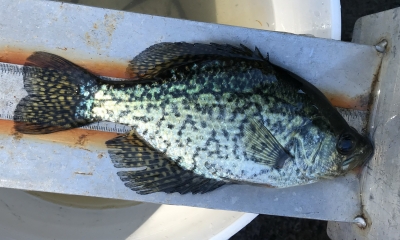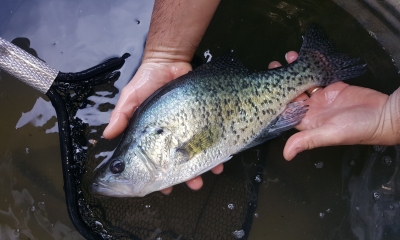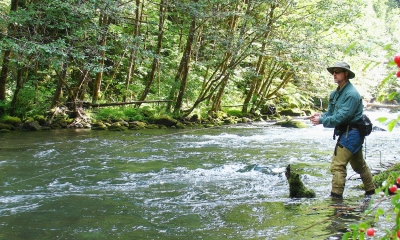
Crappie
Crappie are scrappy fighters and excellent table fare. They do best in larger lakes and reservoirs where they congregate around pilings, sunken logs, underwater brush, weed beds and rocks.

Types of Crappie

Features: Black crappie are silvery in color with numerous black or dark green blotches and no distinct vertical bars. This results in a darker overall color than seen in white crappie. The forehead is dished, but not as much as in the white crappie. The dorsal fin usually has seven or eight spines and its length is equal to or greater than the distance between the dorsal fin and eye.
Habitat: Black crappie do best in clear waters of medium-sized lakes, reservoirs and large slow moving streams. They are less tolerant of flowing and muddy water than white crappie and more associated with aquatic vegetation. Black crappie begin life feeding primarily on zooplankton. As they grow they begin taking increasingly larger percentages of insects, other larger invertebrates and small fish.
Technique: Crappie fishing is best during the cool weather of early spring when they inhabit the shallow ends of coves, and also in the fall. At these times, crappie congregate in loose schools around sunken logs, brushy cover or just beyond the weeds in water 6 to 15 feet deep. As with sunfish, the hardest part of catching crappie is finding the schools. Best fishing is during the early morning or in the evening when they often feed on the surface. During the winter crappies often move to deeper water along vertical structure such as pilings or dams. Begin by fishing near likely looking cover or structure at different depths until you find a school. A bobber and jig rig is the favored setup. Crickets, grasshoppers, and worms rigged the same way on a size 10 or 12 bait hook are also effective. Experienced anglers often fish jigs without a bobber, but a bobber rig will prevent many hang-ups. For jigs, the “smaller-the-better” seems to be the rule, with some experienced anglers using jigs as small as 1/80th ounce. Jigs come in many colors, but red and white, green and white, and chartreuse are popular. Light monofilament line of 4 to 6 pound test is necessary to achieve a lifelike action in these lures. Jig hooks may also be tipped with a crappie “nibble” to give them scent.

Features: White crappie are often confused with black crappie. White crappie have silvery bodies with blackish-green mottling forming narrow vertical bars on the sides. The forehead is more dished than in the black crappie. The dorsal fin has five or six spines and its length is less than the distance between the dorsal fin and eye.
Habitat: White crappie do best in larger lakes and reservoirs and are more tolerant of turbidity and less dependent on aquatic vegetation than black crappie. They congregate around pilings, sunken logs, underwater brush, weed beds and rocks. White crappie begin life feeding primarily on zooplankton. As they grow they begin taking increasingly larger percentages of insects, other larger invertebrates and small fish.
Technique: Crappie fishing is best during the cool weather of early spring when they inhabit the shallow ends of coves, and also in the fall. At these times, crappie congregate in loose schools around sunken logs or brushy cover or just beyond the weeds in water 6 to 15 feet deep. As with sunfish, the hardest part of catching crappie is finding the schools. Best fishing is during the early morning or in the evening when they often feed on the surface. During the winter crappies often move to deeper water along vertical structure such as pilings or dams. Begin by fishing near likely looking cover or structure at different depths until you find a school. A bobber and jig rig is the favored setup (see diagram). Crickets, grasshoppers, and worms rigged the same way on a size 10 or 12 bait hook are also effective. Experienced anglers often fish jigs without a bobber, but a bobber rig will prevent many hang-ups. For jigs, the “smaller-the-better” seems to be the rule, with some experienced anglers using jigs as small as 1/80th ounce. Jigs come in many colors, but red and white, green and white, and chartreuse are popular. Light monofilament line of 4 to 6 pound test is necessary to achieve a lifelike action in these lures. Jig hooks may also be tipped with a crappie “nibble” to give them scent.

